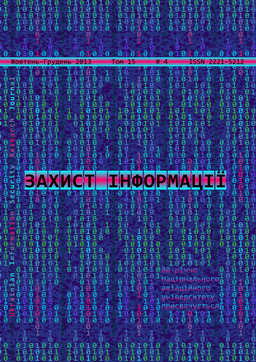Method of intruder detection and identification in information & communication systems
DOI:
https://doi.org/10.18372/2410-7840.15.5733Keywords:
intruder detection system, information security intruder, identification, anomaly detection in information & communication system, method, fuzzy logic, basic model of intruder identification, logic-linguistic connection, heuristic rules, expert estimationAbstract
The providing of state information resources security is inextricably connected with information security intruder's activity in information & communication systems where restricted data is circulating. The modern intruder detection systems, based on heuristic principle of information security violation detection, have a disadvantage because these are basically oriented on mathematical models which require much time to prepare statistic data. Mathematical models based on expert approach are more effective in this way. The method proposed in paper allows to solve the problem of intruder detection and identifying in information & communication systems and networks, which are weakly-formalized fuzzy environment. In the method elements of fuzzy logic are used to the previous decision of the violation & the intruder identification and precise basis of conventional logic that provides clarifying identification. The method consists of such stages: selection of the method for determining the importance of factors, the formation of categories sets of intruder and parameters, forming standards of fuzzy parameters, forming the set of heuristic rules, forming connections of intruder category with parameters, phasing of fuzzy parameters and definition clear parameters, processing and forming of parameters corteges, results formation. The method's work is organized in three phases: preparation, work with fuzzy parameters and work with clear parameters. On the basis of this method can be synthesized heuristic type intruder detection & identification system with high performance in fuzzy terms by the use of expert methods.
References
Корт С.С. Структура систем обнаружения нарушителя (СОН)[Електронній ресурс]: стаття /
С. С. Корт. — Режим доступу: http://www.ssl. stu.neva.ru/sam/.
КорченкоА. Г. Построение систем защиты информации на нечетких множествах [Текст] : Теория и практические решения / А. Г. Корченко. — К. : МК-Пресс, 2006. — 320 с.
Волянська В. В. Система виявленняаномалій на основінечітких моделей [Текст] / В. В. Волянська,
A. О. Корченко, Є. В. Паціра // Зб. наук.пр. Інституту проблем моделювання в енергетиці НАН Україниім. Г. Є Пухова. — Львів : ПП «Системи, технології, інформаційніпослуги», 2007. — [Спец. випуск]. — Т.2. — С. 56—60.
Корченко О. Г. Системи захистуі нформації [Текст] :Монографія / О. Г. Корченко. — К. : НАУ, 2004. — 264 с.
Гізун А.І. Основні параметри для ідентифікації порушника інформаційної безпеки / А.І. Гізун, B. В. Волянська, В.О. Риндюк, С.О. Гнатюк // Захист інформації. — 2013. —№1 (58). — С.66-75.
Волянська В.В. Моделі еталонів лінгвістичних змінних для систем виявлення та ідентифікації порушника інформаційної безпеки// В.В. Волянська, А.І. Гізун, В.О. Гнатюк / Безпека інформації. -№1 (19). — 2013. - С. 13-21.
Гізун А.І. Евристичні правила на основі логіко-лінвистичних зв'язок для виявлення та ідентифікації порушника інформаційної безпеки / А.І. Гізун, В.В. Волянська, О.В. Гавриленко, А.О. Корченко / / Захист інформації. — 2013. —№3 (60). - С.251-257.
Горніцька Д.А. Визначення коефщенпв важливості для експертного оцінювання у галузі інформаційної безпеки / Д.А. Горніцька, В.В Волянська, А.О. Корченко / / Захист інформації. — 2012. — №1 (54). — С. 108-121.
Kort S.S. The structure of intruder détection systems [Electronic resource]: abstract / S.S. Kort. — Modeofaccess: http://www.ssl.stu.neva.ru/sam/
Korchenko A.G. Development of the security systems on fuzzy sets. Theory and practical solutions / A.G. Korchenko, K.: "MK-Press", 2006, 320 P.
Korchenko А.О. Anomaly detection system based on fuzzy models / А.О. Korchenko, Ye.V. Patsira, V.V. Volyanska // Modern trainer and educational complexesand systems. — L.: Institute for Modelling in Energy NAS of Ukraine named. G.Ye. Pukhov, 2007, Т.2., P. 56-60.
Korchenko A.G. System of information security /
A. G. Korchenko, K.: NAU, 2004, 264 P.
Gizun A.I. The main parameters to identify the intruder of information security / A.I. Gizun, V.V. Volyanska, V.O. Ryndyuk, S.O. Gnatyuk // Ukrainian Information Security Research Journal. — 2013. —№1 (58). — P.66-75.
VolyanskaV.V. Models of standards of linguistic variables for detection and identification the intruder of information security// V.V. Volyanska,A.I. Gizun, V.O. Gnatyuk / Ukrainian Scientific Journal of Information Security. -№1 (19). — 2013. -P. 13-21.
Gizun A.I. Heuristic rules based on logic-linguistic connection for information security intruder's detection and identification / A.I. Gizun, V.V. Volyanska, O.V. Gavrylenko, A.O. Korchenko // Ukrainian Information Security Research Journal. — 2013. —№3 (60). — P.251-257.
Gornits'kaD.A. Coefficients determining of importance for the expert assessment in information security / D.A. Gornits'ka, V.V. Volyanska, A.O. Korchenko // Information Security Research Journal. — 2012. — №1 (54) . — P. 108-121
Downloads
Issue
Section
License
Authors who publish with this journal agree to the following terms:- Authors retain copyright and grant the journal right of first publication with the work simultaneously licensed under a Creative Commons Attribution License that allows others to share the work with an acknowledgement of the work's authorship and initial publication in this journal.
- Authors are able to enter into separate, additional contractual arrangements for the non-exclusive distribution of the journal's published version of the work (e.g., post it to an institutional repository or publish it in a book), with an acknowledgement of its initial publication in this journal.
- Authors are permitted and encouraged to post their work online (e.g., in institutional repositories or on their website) prior to and during the submission process, as it can lead to productive exchanges, as well as earlier and greater citation of published work (See The Effect of Open Access).

